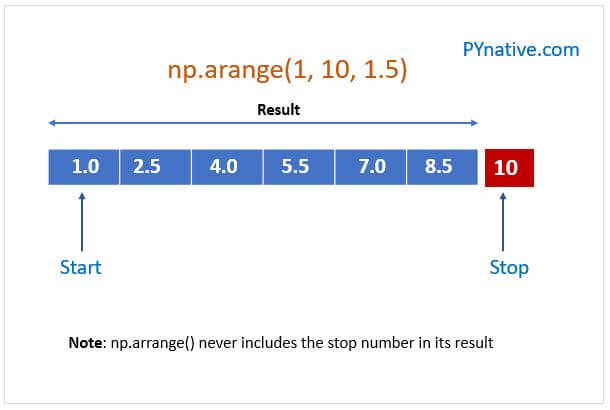In this article, you will learn how to generate a range of floating-point numbers in Python.
The Python range() works only with integers. It doesn’t support the float type, i.e., we cannot use floating-point/decimal value in any of its arguments.
For example, If you use range() with float step argument, you will get a TypeError 'float' object cannot be interpreted as an integer.
Goals of this article –
- Use NumPy’s
arange()andlinspace()functions to use decimal numbers in a start, stop and step argument to produce a range of floating-point numbers. - Use Python generator to produce a range of float numbers without using any library or module.
Table of contents
Range of floats using NumPy’s arange()
The NumPy library has various numeric and mathematical functions to operate on multi-dimensional arrays and matrices.
NumPy has the arange() function to get the range of floating-point numbers. It has the same syntax and functionality as a Python built-in range() function. Also, it allows us to use floating-point numbers in the start, stop and step arguments.
Syntax of np.arange() function
np.arange (start, stop, step)Code language: Python (python)Time needed: 5 minutes
How to generate a range of floats in Python
- Install numpy module
NumPy doesn’t come with default Python installation. You can install it using
pip install numpy. - Import numpy module
Import numpy module using the
import numpy as npstatement. - Use numpy.arange()
Pass float numbers to its start, stop, and step argument. For example,
np.arange(0.5, 6.5, 1.5)will return the sequence of floating-point numbers starting from 0.5 up to 6.5.
Example
Note: As you can see in the output, We got decimal numbers starting from 0.0 to 4.0. If you notice, np.arange() didn’t include 4.5 in its result because it but never includes the stop number in its result. It stops before taking the last step.
Also, see: Python range() and for loop exercise.
Use float number only in step argument
Let see how to use a floating-point step along with a start and stop integers in np.arange() to generate floating-point numbers of a specific interval. In this example, the step value is 2.5.
Reverse float range
Use the reversed() function to display the sequence of float numbers produced by a np.arange() by descending order.
Range for negative float numbers
let’s see how to use all negative float numbers in np.arange().
Range of floats using numpy.linspace()
Let’s see how to use a np.linspace() to get a range of float numbers.
The numpy.linspace() returns number spaces evenly w.r.t interval. Similar to arange, but instead of step, it uses a sample number.
We need to define the start point and an endpoint of an interval, and then specify the total number of samples you want within that interval (including the start and the endpoint). The numpy.linspace function will return a sequence of evenly spaced values on that interval
Syntax
np.linspace(start, stop, num, endpoint)Code language: Python (python)Parameters
start: The starting position of the range, by default, starts with 0 if not specified.stop: The end of the interval range.num: The number of samples to generate, default is 50. It cannot be negative, i.e., The Total numbers you want in the output range.endpoint: Set it toFalseif you don’t’ want to include the stop value in the result.
Example
Note: The numpy.linspace() returns number spaces evenly w.r.t interval. We cannot pass custom step value; instead, we can decide how many samples we want spaces evenly w.r.t interval.
Range of floats using generator and yield
What to do if you don’t want to use the numpy library just for arange() and linspace() function?
In this case, you can use Python generators and yield to write a custom function to generate a range of float numbers.
You can define a generator to replicate the behavior of Python’s built-in function range() in such a way that it can accept floating-point numbers and produces a range of float numbers.
The following code divided into 2 Sections.
- The custom
frange()function. - Another section tests custom
frange()function using the floating-point number with the following approaches.- Positive float numbers in
frange()arguments. - With negative float numbers in
frange()arguments. - Both negative and positive float step in
frange()arguments.
- Positive float numbers in
Now, let see the example.
Output:
start = 1.5 stop = 5.5 step = 0.5 1.5, 2, 2.5, 3, 3.5, 4, 4.5, 5, start = -0.1 stop = -0.5 step = -0.1 -0.1, -0.2, -0.3, -0.4, start = 0.5 stop = 0.1 step = -0.1 0.5, 0.4, 0.3, 0.2, start = 0.0 stop = 7.5 step = 1.0 0, 1, 2, 3, 4, 5, 6, 7, start = 2.5 stop = 7.5 step = 1.0 2.5, 3.5, 4.5, 5.5, 6.5,
Positive float number sequence using a generator
If you need a range of only positive float-numbers, you can try this code.
Negative float numbers sequence using a generator
If you need a range of only negative float-numbers, you can try this code.
Output:
Using Negative float number in range function start= -0.1 stop= -0.5 step= -0.1 -0.1, -0.2, -0.3, -0.4,
Range of floats using a list comprehension
Let’s see how to use list comprehension to generate a range of float numbers from 0.5 to 9.5.
Here we are using the range function to generate numbers and dividing each number by 10.0 to get a float number.
Range of floats using a itertools
Let’s see how to generate floating-point range using a itertools.
Next Steps
I want to hear from you. What do you think of this article on the Python float range? Do you have any better alternative to generate a range of float numbers in Python? let me know by leaving a comment below.
Also, try to solve the Python for loop and range() Exercise for a better understanding of Python’s range().
